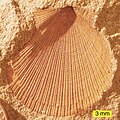| Logan Formation | |
|---|---|
| Stratigraphic range: | |
 Logan Formation exposed in Wooster, Ohio. | |
| Type | Sedimentary |
| Unit of | Waverly Group |
| Sub-units | Berne, Byer, Allenville, Vinton |
| Underlies | Maxville Limestone, Pottsville Group, and Rushville Shale |
| Overlies | Cuyahoga Formation; Black Hand Sandstone |
| Thickness | 0 to 40 m |
| Lithology | |
| Primary | sandstone, siltstone, conglomerate |
| Other | shale |
| Location | |
| Region | Appalachian Basin |
| Country | United States |
| Extent | Ohio, West Virginia |
| Type section | |
| Named for | Logan, Ohio |
| Named by | Andrews, 1870 |
The Logan Formation is the name given to a Lower Carboniferous (early Osagean) siltstone, sandstone and conglomeratic unit exposed in east-central Ohio and parts of western West Virginia, USA.










